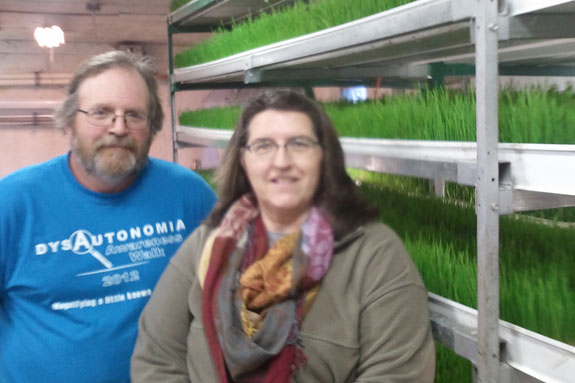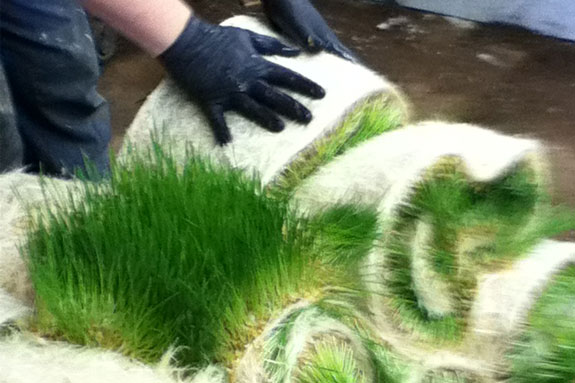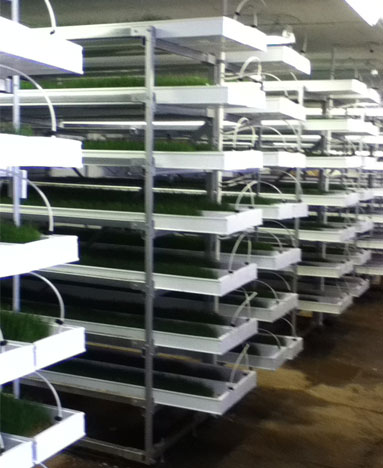This article was #11 of the Top 25 most well-read articles on www.progressivedairy.com in 2014. It was published in the Dec. 11, 2013 Extra e-newsletter. This article was written as a follow up to our No. 1 most well-read article in 2013, “Two dairymen are making profits with sprout fodder systems.” Freelance writer Kelli Boylen addressed online comments from that original article that requested more input from industry experts.
This article was #11 of the Top 25 most well-read articles on www.progressivedairy.com in 2014. It was published in the Dec. 11, 2013 Extra e-newsletter. This article was written as a follow up to our No. 1 most well-read article in 2013, “Two dairymen are making profits with sprout fodder systems.” Freelance writer Kelli Boylen addressed online comments from that original article that requested more input from industry experts.
The article profiled the Lensmires of Cleveland, Wisconsin, and John Stolzfus of Whitesville, New York. Both operations are seeing success with the sprout fodder system. Dr. Daniel Putnam, extension agronomist and forage specialist at the University of California, urged producers to look at the concept skeptically.
“One should take a hard-nosed look at the true costs of producing the hay-equivalent with this sprouted forage. Be sure to include labor, seed, as well as the energy and infrastructure investment,” he said.
“Unless significant benefits can be gained due to the increased digestibility of the fodder, this system is a costly method of producing feed for dairy producers,” agreed Iowa State Extension Dairy Specialist Larry Tranel.
In the article, “ Think outside the silage bag ,” published in the Oct. 17, 2014 print issue, Dr. Silvia Abel-Caines, staff ruminant nutritionist for Organic Valley, says that sprout fodder can work in some situations.
“There is no question that the nutritional content of fresh, clean, sprouted barley will bring additional enzymes and phyto-compounds not available in conserved feeds. But every farm needs to carefully evaluate if the high economical investment of a commercial fodder system fits the budget and the labor required to keep it functional year-round,” she said.
:

Editor's note: This article was written as a follow-up to Progressive Dairyman 's No. 1 most popular article of 2013, " Two dairymen are making profits with sprout fodder systems ."
Farmers using hydroponic systems to grow sprout fodder say they are saving money and their cows are doing well, but many experts remain unconvinced investing in the systems is a good idea.
Growing fodder on the farm
Lensmire Family Farm in Cleveland, Wisconsin, started feeding wheat sprouts to their cows in February of 2013. Tom Lensmire says taking into account the cost of the seed and electricity, they are growing fodder for about 2 cents a pound (not including family labor).
They feed their cows 30 pounds of fodder a day. In the summer they had cut back the cows’ grain intake by about 10 pounds a day, but they have had to add a couple of pounds of grain back in this fall to make up for some low quality hay.
Tom and his wife, Jane, milk a mixed breed herd of 80 cows and they rotationally graze 80 acres. Obtaining land is very competitive in their area, so they purchase all their corn silage, hay and grains. They were looking for an option that allowed them to cut down on purchased feed. They started playing around with growing seeds in their basement to see if they could get results worth their time and investment.
After an initial investment of about $30,000, which included renovating and insulating an existing building and purchasing equipment, they starting feeding wheat sprouts to their cows.
“They dove into it like a kid eating candy,” Lensmire says.
He predicts a two-year payback on their system. Milk production is up slightly, and protein, butterfat and SCC have held steady. Herd health remains good.

Changes Lensmires made to their system since start up include the addition of lights to help lower racks grow better and increasing the tilt of the trays for better water drainage. These changes produced more uniform growth and a thicker root system, which enabled them to harvest an entire tray – measuring 12 feet long and about 9 inches wide – with one pull. They had a few issues with mold on startup, but they found once they made adjustments to the humidity no additives were needed to prevent it.
The fodder tests at 19-20 percent protein. They grow on an eight-day cycle and feed it the day after harvesting to reduce the moisture and allow the total digestible nutrients to go up.
Lensmires say their nutritionist didn’t have any experience with sprout fodder, but she was willing to work with them as they learned together. John Stolzfus of B-A-Blessing farm in Whitesville, New York, is an organic producer who turned to sprouts as a way to keep costs down.
He started corresponding with farmers in Australia as well as companies who sold systems. They renovated the hayloft in the upper-story of their barn, invested about $5,000 in equipment, and have now been feeding sprouts for about three years. Stolzfus also dealt with the learning curve of finding the best settings for temperature, humidity and air flow.
He initially tried low levels of chlorine (like that used in a city water system) to try to control mold, but he has found good results with simply aerating the seeds while they are in the soak stage.
Stolzfus started out using barley, but finding clean, quality seed has become an issue. He is now using rye with “fairly good success,” and he has been happy with triticale.
Stolzfus says within a week of when he started feeding it, the cows would wait to eat their grain until the fodder was gone. He reports milk production has been steady, butterfat and protein are up, SCC has gone down, and best of all his feed costs are down.
“I have always looked at the living plant as the best thing you can feed,” Stolzfus says, adding that the live plant matter also enhances rumen function and they are better able to process everything they are fed.
As for the nutritionists that say feeding sprouts cannot work, Stolzfus says they need to go to a farm that is doing it. “They should look at the herds that are doing it before making their decision.”
Dr. Daniel Putnam, extension agronomist and forage specialist at the University of California,says although he appreciates that some folks feel that feeding sprouts works for them, “more analysis is necessary.”
“While I have little doubt that sprouted grain is highly palatable, unless someone can come up with data that shows the sprouted grain to have significantly unique or better feeding quality than grain itself or to comparative hays, or that the sprouts can be produced at significantly lower cost than purchased hay or grain or home-grown feeds, the concept should be looked at skeptically,” Putnam says.
Putnam explains they have found feed DM losses of 25-30 percent with the system, and the Sandia study in New Mexico found the same."That’s like taking a pile of good feed grain and automatically reducing it by one-fourth before you feed.Does this make sense?”
Putnam says buying hay, even at a premium price, will likely be more cost effective than growing sprouts.“One should take a hard-nosed look at the true costs of producing the hay-equivalent with this sprouted forage.Be sure to include labor, seed, as well as the energy and infrastructure investment.”
Iowa State Extension Dairy Specialist Larry Tranel says he is not yet convinced that the system can save money and not negatively impact milk production or solids. He encourages dairy producers considering the system to “sit back until more definitive comparison studies are done with feeding fodder versus conventional feeds” before making the investment in a fodder system.
Tranel says research reviews are “inconsistent in any dry matter production or animal performance benefits.” He authored a paper titled, “Hydroponic Fodder Systems for Dairy Cattle.” He reports, “… unless significant benefits can be gained due to the increased digestibility of the fodder, this system is a costly method of producing feed for dairy producers.”
He adds, “Why not just feed the barley grain?”

Research underway
A. Fay Benson, Small Dairy Support at Cornell University, has started a study on the effects on milk composition from feeding barley fodder to milk cows. He expects that by replacing the grain in the diet of the dairy cow with fodder, there will be a reduction of omega-6 and an increase of omega- 3 in the animal’s diet. It is expected that the milk testing will show this healthy improvement in the ratio of omega-3 to omega-6.
The results will not only be available to dairy producers sometime in 2014, they will also be shared with Organic Valley Milk Coop as they try and decide whether fodder feeding will be an acceptable practice for farms requesting to participate in their grass-fed milk products. The study is supported by the Towards Sustainability Foundation.
Benson is alsocreating fact sheets on the growing and feeding of barley fodder for dairy animals,which will be available next year.
Brad Heins,assistant professor of organic dairy production at the University of Minnesota, also recentlyreceived a grant to evaluate fodder production systems.This organic dairy project is set to begin April 2014 and end Fall 2016. There are three parts to the study, which involves 40 heifers and 40 cows.
Phase one will look at alternative grains (barley, wheat, oats, triticale, rye) harvested at six, seven or eight days and evaluate their potential benefits of feeding to dairy cattle in a fodder system.
During phase two of the study, groups of cows will be fed fodder and TMR compared to a TMR with 10 pounds of corn during the grazing season.
During the third year (phase three) of the project, fodder will be fed to organic dairy heifers on pasture to evaluate growth potential and profitability.
It is hoped that research will resolve the conflicting views of if and how feeding sprouts to dairy cows can work. In the meantime, producers like Stolzfus and the Lensmires have found enough success with thesprout fodder to continue on with the systems as a main source of feed for their herd. PD
Kelli Kaderly-Boylen is a freelancer writer in Waterville, Iowa.
PHOTOS
TOP: Tom and Jane Lensmire pose for a photo next to wheat sprouts they grow as cow fodder at their family farm in Cleveland, Wisconsin.
MIDDLE: Rolls of wheat sprouts are being prepared in this photo at the farm.
BOTTOM: The couple started growing the sprouts in February, and say they feed their cows 30 pounds of fodder a day. Photos courtesy of Tom and Jane Lensmire.






